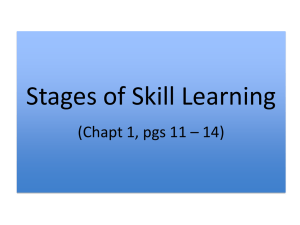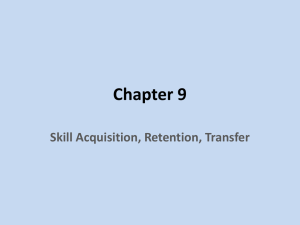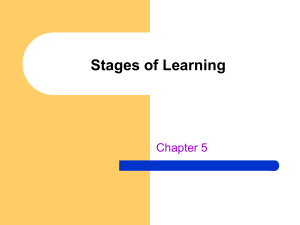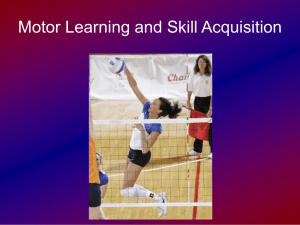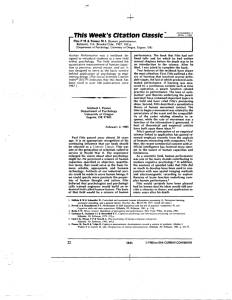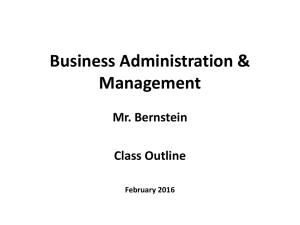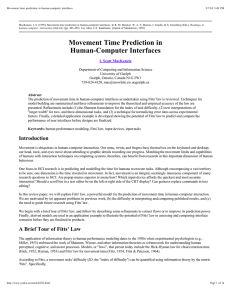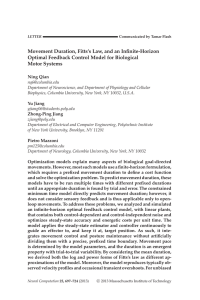Electrode Placement for Chest Leads, V1 to V6
advertisement
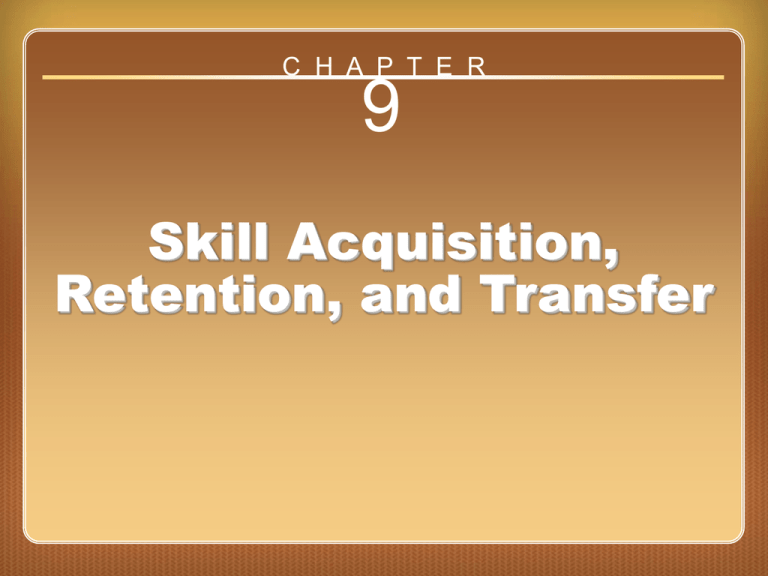
C H A P T E R 9 Skill Acquisition, Retention, and Transfer Chapter 9 Skill Acquisition, Retention, and Transfer Objectives • This chapter will help you to understand the following: – Principles of the skill acquisition process – Two conceptualizations of learning stages during skill acquisition – Factors that influence the retention of skills after periods of no practice – Factors that influence the transfer of skills to new tasks or performance situations Specificity of Practice • In general, specificity of learning suggests that what you learn depends largely on what you practice. – Practicing in a particular environment or workspace often leads to better performance mainly in that workspace. – The sensory feedback resulting from performance during specific types of practice becomes part of the learned representation for skill. Learning Versus Performance During Practice • The learner who attempts to perform as well as possible in practice tends to be inhibited from modifying movements from attempt to attempt. • Providing both practice sessions and test sessions during practice can help overcome the detriment to learning. Benefits of Practice • Improved capability to perform some skill on future demand • Improved perceptual skills • Improved attention through reduced capacity demands and reduced effector competition • Improved motor programs • Improved error detection Stages of Learning • Fitts’ stages were specifically designed to consider perceptual–motor learning placing heavy emphasis on how the cognitive processes invested in motor performance change as a function of practice. • Bernstein identified stages of learning from a combined motor control and biomechanical perspective. Fitts’ Stage 1: Cognitive Stage • The dominant questions concern goal identification, performance evaluation, what to do, when to do it. • Verbal and cognitive abilities dominate, and verbalizable information is useful. • Gains in proficiency in this stage are very rapid and large, indicating that more effective strategies for performance are being discovered. Fitts’ Stage 2: Fixation Stage • The learner’s focus shifts to organizing more effective movement patterns. • In skills requiring quick movements, such as a tennis stroke, the learner begins to build a motor program to accomplish the movement requirements. • In slower movements, such as balancing in gymnastics, the learner constructs ways to use movement-produced feedback. (continued) Fitts’ Stage 2: Fixation Stage (continued) • Inconsistency gradually decreases—closedskill movements begin to be more stereotypic and those open-skill movements become more adaptable. • Enhanced movement efficiency reduces energy costs, and self-talk becomes less important for performance. • Learners begin to monitor their own feedback and detect their errors. Fitts’ Stage 3: Autonomous Stage • It is usually associated with the attainment of expert performance. • The decreased attention demanded by both perceptual and motor processes frees the individual to perform simultaneous higherorder cognitive activities. • Self-confidence increases and the capability to detect and correct one’s own errors becomes more fine-tuned. Bernstein’s Stage 1: Reduce Degrees of Freedom • The initial problem facing the learner is what to do with all of the possible degrees of freedom of movement that are available for the body. • Bernstein considered that the solution was to reduce the movement of nonessential or redundant body parts in the initial stage of learning by freezing degrees of freedom. Bernstein’s Stage 2: Release Degrees of Freedom • The learner attempts to improve performance by releasing some of the degrees of freedom that had initially been frozen. • Particularly useful in tasks that require power or speed, because the degrees of freedom that have been released could allow for faster and greater accumulation of forces. Bernstein’s Stage 3: Exploit Passive Dynamics • The performer learns to exploit the passive dynamics of the body—essentially, the energy and motion that come for free with the help of physics. • The movement becomes maximally skilled in terms of effectiveness (achieving the result with maximum assuredness) and efficiency (minimum outlay of energy). Limitations of Fitts’ and Bernstein’s Stages • Neither was meant to describe learning as a series of discrete, nonlinear, and unidirectional stages. • Fitts considered performance change to be regressive as well as progressive. • Task differences also play an important role in the stage views of both Fitts and Bernstein. Forgetting • Long-term retention depends largely on the nature of the task. – Discrete tasks (especially those with a relatively large cognitive component) are forgotten relatively quickly. – Continuous tasks are retained very well over long periods of no practice. – The amount of original practice will influence the relative amount of retention for these tasks. Figure 9.4 Figure 9.5 Warm-Up Decrement • Warm-up decrement refers to a specific type of retention deficit due to the loss of an activity set. • Set is a collection of psychological activities, states, or adjustment and processes that are appropriate and support performance while an activity is ongoing. Transfer and Similarity • Transfer between skills depends on the skills’ movement or perceptual similarity. • The concept of similarity among skills involves several classes of common features: – Common movement patterning – Common perceptual elements – Common strategic or conceptual elements Transfer of Part Practice to Whole Performance • Some skills are enormously complex; in such situations the instructor cannot present all aspects of the skill at once for practice. • An approach is to divide the task into meaningful units that can be isolated for separate part practice with the goal of integrating the units into the whole skill for later performance. Principles of Part Practice • For very slow, serial tasks with no component interaction, part practice on the difficult elements is very efficient. • For very brief, programmed actions, practice on the parts in isolation is seldom useful and can be detrimental to learning. • The more the components of a task interact with each other, the less the effectiveness of part practice. Simulation and Transfer • A simulator is a practice device designed to mimic features of a real-world task. – Are often very elaborate, sophisticated, and expensive but don’t need to be – Can be an important part of an instructional program, especially when the skill is expensive or dangerous, where facilities are limited, or where real practice is not feasible Physical Versus Psychological Fidelity • Fidelity is the degree to which the simulator mimics the criterion task. • Physical fidelity is the degree to which the surface features of a simulation and the criterion task are identical. • Psychological fidelity is the degree to which the behaviors produced in a simulator are identical to the behaviors required by the criterion task.
